Crustal controls on light noble gas isotope variability along the Andean Volcanic Arc
Affiliations | Corresponding Author | Cite as | Funding information- Share this article





-
Article views:402Cumulative count of HTML views and PDF downloads.
- Download Citation
- Rights & Permissions
top
Abstract
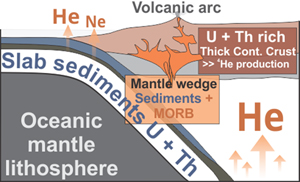
Figures
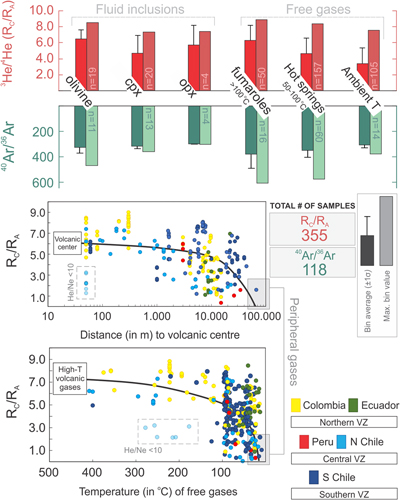 Figure 1 Distribution of helium and argon isotopic data (averages and maximum values) per sample category. Bottom: relation between RC/RA data in free gases, their sampling temperature, and distance to respective volcanic centres (Table S-2). | 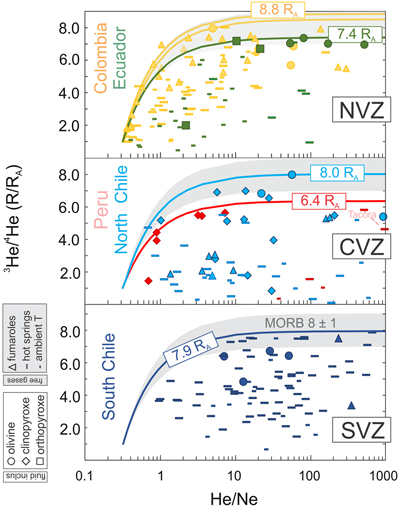 Figure 2 3He/4He vs 4He/20Ne data in FIs and free gases. Binary mixing (air-magmatic end member) curves calculated with maximum RC/RA values for each segment. | 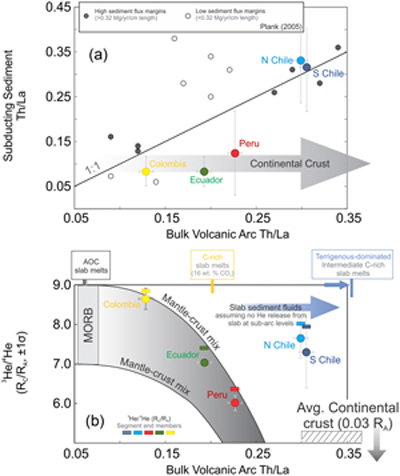 Figure 3 (a) Average Th/La in subducting sediments and volcanic arcs (Plank, 2005). For Andean segments, bulk sediment and arc compositions (Table S-3) are derived from Plank (2014) and the Andean GEOROC dataset, respectively (see Supplementary Information S-4). (b) 3He/4He averages and end members (this work) vs. bulk Th/La compositions of respective segments; the grey area indicates a binary mixing line between MORB and continental crust. | 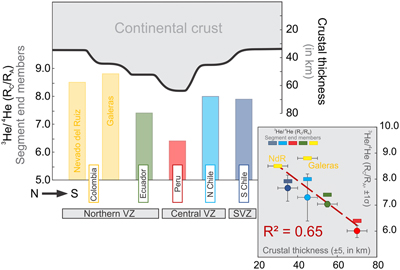 Figure 4 Crustal thickness variations along the Andes (transect); bottom, 3He/4He end members of respective arc segments (Fig. 2). Inset: co-variation of He isotopic signatures (avg. ±1σ, and end members) and crustal thicknesses at the arc scale; due to the crustal thickness anomaly detected at Nevado del Ruiz, the latter and Galeras are plotted separately. |
| Figure 1 | Figure 2 | Figure 3 | Figure 4 |
top
Introduction
Subduction zones are the main drivers of volatile exchange between the Earth’s interior reservoirs and the atmosphere (Zellmer et al., 2015
Zellmer, G.F., Edmonds, M., Straub, S.M. (2015) Volatiles in subduction zone magmatism. Geological Society, London, Special Publications 410, 1–17.
). Studying the chemical and isotopic imprints of arc-related fluids is key to resolve their origin and fate along convergent margins (Hilton et al., 2002Hilton, D.R., Fischer, T.P., Marty, B. (2002) Noble gases and volatile recycling at subduction zones. Reviews in Mineralogy and Geochemistry 47, 319–370.
). Noble gases in arc magmatic/hydrothermal fluids, and trapped as fluid inclusions (FIs) in minerals, are fundamental tracers of the relative contributions of potential sources at work in an arc context: the mantle, the subducted slab, and the arc crust (Sano and Fischer, 2013Sano, Y., Fischer, T.P. (2013) The analysis and interpretation of noble gases in modern hydrothermal systems. In: Burnard P. (Ed.) The Noble Gases as Geochemical Tracers. Springer, Berlin, Heidelberg, 249–317.
).Poreda and Craig (1989)
Poreda, R., Craig, H. (1989) Helium isotopes ratios in circum-Pacific volcanic arcs. Nature 338, 473–478.
were among the first to investigate arc gas emissions for their noble gas isotope compositions. They reported 3He/4He ratios close to those found in MORBs (8 ± 1; Graham, 2002Graham, D.W. (2002) Noble gas isotope geochemistry of mid-ocean ridge and ocean island basalts: Characterization of mantle source reservoirs. Reviews in Mineralogy and Geochemistry 47, 247–317.
), implying a dominant helium origin from the mantle wedge above the subducted plate. However, Hilton et al. (2002)Hilton, D.R., Fischer, T.P., Marty, B. (2002) Noble gases and volatile recycling at subduction zones. Reviews in Mineralogy and Geochemistry 47, 319–370.
estimated an average of 5.4 RA for volcanic arc gases globally. Lower than MORB 3He/4He ratios have been explained invoking either (i) assimilation of 4He-rich crustal fluids during magma crustal storage/ascent (e.g., Mason et al., 2017Mason, E., Edmonds, M., Turchyn, A.V. (2017) Remobilization of crustal carbon may dominate volcanic arc emissions. Science 357, 290–294.
), or (ii) addition of radiogenic 4He to the mantle wedge (Hanan and Graham, 1996Hanan, B.B., Graham, D.W. (1996) Lead and Helium Isotope Evidence from Oceanic Basalts for a Common Deep Source of Mantle Plumes. Science 272, 991–995.
) via subducted slab sediments (if U + Th-rich sediments are involved; Kagoshima et al., 2015Kagoshima, T., Sano, Y., Takahata, N., Maruoka, T., Fischer, T.P., Hattori, K. (2015) Sulphur geodynamic cycle. Scientific Reports 5, 8330.
).The Andean volcanic arc offers a unique opportunity to evaluate the crust versus slab hypotheses. The ∼7000 km long arc is subdivided into four volcanic zones (VZs), three of which are investigated here (Northern VZ, Colombia and Ecuador; Central VZ, Peru and North Chile; and Southern VZ, South Chile). Ancellin et al. (2017)
Ancellin, M.-A., Samaniego, P., Vlastelic, I., Nauret, F., Gannoun, A., Hidalgo, S. (2017) Across-arc versus along-arc Sr-Nd-Pb isotope variations in the Ecuadorian volcanic arc. Geochemistry Geophysics Geosystems 18, 1163–1188.
and Mamani et al. (2010)Mamani, M., Wörner, G., Sempere, T. (2010) Geochemical variations in igneous rocks of the Central Andean orocline (13°S to 18°S): Tracing crustal thickening and magma generation through time and space. GSA Bulletin 122, 162–182.
noted, for the Ecuadorian and Peruvian arcs, respectively, high degrees of crustal assimilation by magmas erupted in the region. Along the trench, the age of the subducted oceanic floor (46.2 Ma in North-Central Chile to 10.3 Ma in South Chile; Syracuse et al., 2010Syracuse, E.M., van Keken, P.E., Abers, G.A., Suetsugu, D., Bina, C., Inoue, T., Wiens, D., Jellinek, M. (2010) The global range of subduction zone thermal models. Physics of the Earth and Planetary Interiors 183, 73–90.
) and the degree of obliquity of the subducted slab (similar across the active volcanic zones) are other key factors impacting magma genesis and distribution of active volcanism in the Andes (Stern, 2004Stern, C.R. (2004) Active Andean Volcanism. Andean Geology 31, 161–206.
). Moreover, slab contributions have been noted in the C content of volcanic gas emissions (Aiuppa et al., 2017Aiuppa, A., Fischer, T.P., Plank, T., Robidoux, P., Di Napoli, R. (2017) Along-arc, inter-arc and arc-to-arc variations in volcanic gas CO2/ST ratios reveal dual source of carbon in arc volcanism. Earth-Science Reviews 168, 24–47.
), whose compositions strongly correlate with the nature of subducted sediments in each region (Plank, 2014Plank, T. (2014) 4.17 - The Chemical Composition of Subducting Sediments. In: Holland, H.D., Turekian, K.K. (Eds.) Treatise on Geochemistry. Second Edition, Elsevier, Oxford, 607–629.
). However, in addition to the role of the slab, crustal processes have also been invoked (Hidalgo et al., 2012Hidalgo, S., Gerbe, M.C., Martin, H., Samaniego, P., Bourdon, E. (2012) Role of crustal and slab components in the Northern Volcanic Zone of the Andes (Ecuador) constrained by Sr-Nd-O isotopes. Lithos 132–133, 180–192.
), especially for noble gases compositions previously reported for the continental arc (e.g., Hilton et al., 1993Hilton, D.R., Hammerschmidt, K., Teufel, S., Friedrichsen, H. (1993) Helium isotope characteristics of Andean geothermal fluids and lavas. Earth and Planetary Science Letters 120, 265–282.
).Here, we present the very first noble gas data from Sabancaya, Ubinas, and El Misti (Central Volcanic Zone, Peru) and report on new noble gas chemical and isotope compositions for Villarica (South Chile). These were obtained from the analyses of bulk (primary and secondary) fluid inclusion compositions in minerals (olivine and pyroxene), which are key in providing noble gas compositions of the magmatic source, especially when surface emissions are absent or difficult to access. Our new helium data, integrated with noble gas data from other volcanic zones in the Andes, are used to resolve crustal versus slab controls on noble gas isotope variability along the arc.
top
Results
Our noble gas results derive from CO2-dominated FIs trapped in olivine (Villarica, South Chile) and clinopyroxene (Peru) phenocrysts as gas (vapour) bubbles during and after magma crystallisation. The phenocrysts were handpicked from pyroclastic and scoria deposits at Villarica, and ballistic blocks and andesitic lava flows in Peru (Supplementary Information S-1). We focus on pyroxene in Peruvian volcanic products as, due to the more evolved nature of magmas produced along the CVZ, olivine is scarce and recurrently found in insufficient amounts for noble gas analyses. We followed identical sample preparation and analytical procedures to those described in Lages et al. (2021)
Lages, J., Rizzo, A.L., Aiuppa, A., Samaniego, P., Le Pennec, J.L., Ceballos, J.A., Narváez, P.A., Moussallam, Y., Bani, P., Schipper, C.I., Hidalgo, S., Gaglio, V., Alberti, E., Sandoval-Velasquez, A. (2021) Noble gas magmatic signature of the Andean Northern Volcanic Zone from fluid inclusions in minerals. Chemical Geology 559, 119966.
for bulk element and isotope composition measurements of noble gases in each sample.Despite low helium concentrations in Peruvian phenocrysts (0.38–1.29 × 10–13 mol/g), we obtain consistent results for Sabancaya, Ubinas, and El Misti volcanoes. The maximum observed 3He/4He ratios range from 5.9 (±0.2) to 6.4 (±0.2) RA (Table S-1). As for Villarica, we measure similar helium concentrations in olivine (only as high as 1.27 × 10–13 mol/g). Both samples analysed yield comparable RC/RA values (6.5 ± 0.1 and 6.7 ± 0.1; Table S-1), below the MORB range, yet significantly higher than that reported in Hilton et al. (1993)
Hilton, D.R., Hammerschmidt, K., Teufel, S., Friedrichsen, H. (1993) Helium isotope characteristics of Andean geothermal fluids and lavas. Earth and Planetary Science Letters 120, 265–282.
of 4.3 ± 0.8 RA.top
An Improved Catalogue for Light Noble Gases in Andean Fluids
Our new data (Table S-1) fill an information gap in the central and southern volcanic zones of the Andes and are interpreted in the context of a noble gas compilation (Table S-2) we assembled from published noble gas studies on quaternary volcanic centres along the arc.
In their global arc compilation, Hilton et al. (2002)
Hilton, D.R., Fischer, T.P., Marty, B. (2002) Noble gases and volatile recycling at subduction zones. Reviews in Mineralogy and Geochemistry 47, 319–370.
listed 81 samples (predominantly <100 °C) with available 3He/4He information for the Andes (117 in Sano and Fischer, 2013Sano, Y., Fischer, T.P. (2013) The analysis and interpretation of noble gases in modern hydrothermal systems. In: Burnard P. (Ed.) The Noble Gases as Geochemical Tracers. Springer, Berlin, Heidelberg, 249–317.
). Our updated catalogue (Supplementary Information S-2) now includes a total of 261 gas samples, with a significantly higher representation of fluid inclusion data analysis. However, and despite the significant increase in the number of samples available (including for other noble gases such as Ar and Ne), the overall dataset remains predominantly dominated (>60 % of the total; Fig. 1) by low temperature (<100 °C) gas emissions. This reflects (i) the difficulty of accessing volcano summits where high temperature fumaroles are typically concentrated, and (ii) the widespread occurrence of more accessible, peripheral manifestations (bubbling springs, steaming grounds, diffuse degassing) in volcano surroundings. Unfortunately, these are recurrently affected by secondary processes, including dilution of “magmatic” fluids by atmospheric/crustal He that ultimately lowers the pristine 3He/4He ratio (e.g., gas manifestations at 0–100 °C and >3 km distance from the volcanic centre exhibit the lowest 3He/4He ratios on average; Fig. 1).
Figure 1 Distribution of helium and argon isotopic data (averages and maximum values) per sample category. Bottom: relation between RC/RA data in free gases, their sampling temperature, and distance to respective volcanic centres (Table S-2).
To overcome these limitations, recent studies have focused on the analysis of olivine- and pyroxene-hosted FIs found in lavas and pyroclastic deposits from active Andean volcanoes lacking noble gas information (e.g., Robidoux et al., 2020
Robidoux, P., Rizzo, A.L., Aguilera, F., Aiuppa, A., Artale, M., Liuzzo, M., Nazzari, M., Zummo, F. (2020) Petrological and noble gas features of Lascar and Lastarria volcanoes (Chile): Inferences on plumbing systems and mantle characteristics. Lithos 370–371, 105615.
). Consequently, our novel data reported here for Ubinas, El Misti, and Sabancaya (Peru, CVZ), where surface gases have traditionally been challenging to measure (due to high level of activity at the open vents), delivers the first characterisation of noble gas signatures in the region. These, alongside our new noble gas results for Villarica (SVZ), provide the most thorough analysis of helium isotope compositions along the Andean volcanic arc.top
Exploring the Catalogue: Surface Gases vs. Fluid Inclusions
Our updated Andean dataset (Table S-2) benefits from the significant addition of FIs data to a yet gas-dominated compilation. More importantly, it ensures significant representability of three Andean arc segments (NVZ, CVZ and SVZ), and especially of some of their current most active volcanoes.
FIs account for only ∼12 % of the helium dataset (Fig. 1). While Ne and Ar exhibit large proportions of atmospheric components, FIs generally exhibit higher 3He/4He ratios than surface gases. Figure 2 explores the 3He/4He populations of three Andean segments, and finds that (with the notable exception of Galeras; Sano et al., 1997
Sano, Y., Gamo, T., Williams, S.N. (1997) Secular variations of helium and carbon isotopes at Galeras volcano, Colombia. Journal of Volcanology and Geothermal Research 77, 255–265.
) FIs yield higher R/RA values than surface gases. Therefore, although FIs can potentially be affected by post-entrapment 3He and 4He in growth and diffusion controlled isotope fractionation, their 3He/4He signatures offer the most faithful record of pristine magmatic source compositions. Our inferred magmatic end member compositions are shown in Figure 2, as derived from using the maximum RC/RA values for each arc segment. These are used below to interpret variations of 3He/4He signature in the mantle source along the arc.
Figure 2 3He/4He vs 4He/20Ne data in FIs and free gases. Binary mixing (air-magmatic end member) curves calculated with maximum RC/RA values for each segment.
top
Subducting Slab or Continental Crust?
Accepting our segment maximum RC/RA values (Fig. 2) as the most representative of the Andean magmatic source(s) (e.g., as those least affected by secondary processes), we find little evidence of radiogenic contributions in Colombia and North/South Chile, in which the magmatic end members yield MORB-like values. However, more radiogenic 3He/4He ratios are observed in Ecuador and Peru (Fig. 2). Our goal below is to address if the drivers of these along arc variations operate (i) deep in the mantle source (via the subducting slab), or (ii) in the crust during magma ascent/storage.
Slab sediments are known as effective U and Th carriers (e.g., Kelley et al., 2005
Kelley, K.A., Plank, T., Farr, L., Ludden, J., Staudigel, H. (2005) Subduction cycling of U, Th, and Pb. Earth and Planetary Science Letters 234, 369–383.
), and the fluids/melts they form by dehydration/melting (Skora et al., 2015Skora, S., Blundy, J.D., Brooker, R.A., Green, E.C.R., de Hoog, J.C.M., Connolly, J.A.D. (2015) Hydrous phase relations and trace element partitioning behaviour in calcareous sediments at subduction-zone conditions. Journal of Petrology 56, 953–980.
) may in principle lead to substantial radiogenic 4He production (with a consequent 3He/4He ratio decrease) in the overriding mantle (Robidoux et al., 2017Robidoux, P., Aiuppa, A., Rotolo, S.G., Rizzo, A.L., Hauri, E.H., Frezzotti, M.L. (2017) Volatile contents of mafic-to-intermediate magmas at San Cristóbal volcano in Nicaragua. Lithos 272–273, 147–163.
). We test the possible role of recycled subducting sediments using the Th/La ratio slab proxy (Supplementary Information S-4; Plank, 2005Plank, T. (2005) Constraints from Thorium/Lanthanum on sediment recycling at subduction zones and the evolution of the continents. Journal of Petrology 46, 921–944.
). The ratio between these fluid-immobile elements is typically low in MORBs (<0.1), elevated in the continental crust (>0.25), and varies in arc basalts (∼0.1–0.4) depending on the composition of sediments subducted at the corresponding trenches.Plank (2005)
Plank, T. (2005) Constraints from Thorium/Lanthanum on sediment recycling at subduction zones and the evolution of the continents. Journal of Petrology 46, 921–944.
demonstrates, for margins with high sediment fluxes (>0.32 Mg/yr/cm length), a correlation between Th/La in arc rocks and subducting sediments at corresponding trench. North and South Chile are the only Andean margins that fall in the high sediment flux category (0.53 and 0.55 Mg/yr/cm length, respectively), and their rock/sediment Th/La association consistently plot along the global array of Plank (2005)Plank, T. (2005) Constraints from Thorium/Lanthanum on sediment recycling at subduction zones and the evolution of the continents. Journal of Petrology 46, 921–944.
, suggesting effective transfer of sediment-derived fluids to arc magmas in these regions (Fig. 3a, Table S-3). By contrast, Colombia, Ecuador and Peru, all low flux segments, exhibit a large spread in bulk volcanic rock Th/La compositions and 3He/4He ratios, and no obvious correlation with sediment Th/La (Fig. 3a). Instead, the Th/La vs. 3He/4He ratios association (Fig. 3b) is more consistent with the involvement of crustal fluids in the latter segments. We cannot exclude however, based on the results of Figure 3b, that the ∼1 RA difference between Colombia (8.5 and 8.8 RA) and North/South Chile (7.9 and 8.0 RA, high Th/La ratios of ∼0.33 and 0.32, respectively; Fig. 3b; Tables S-3, S-4; Plank, 2014Plank, T. (2014) 4.17 - The Chemical Composition of Subducting Sediments. In: Holland, H.D., Turekian, K.K. (Eds.) Treatise on Geochemistry. Second Edition, Elsevier, Oxford, 607–629.
) is, at least partially, due to a higher U-Th slab recycling via subduction of sediments in the latter segment.
Figure 3 (a) Average Th/La in subducting sediments and volcanic arcs (Plank, 2005
Plank, T. (2005) Constraints from Thorium/Lanthanum on sediment recycling at subduction zones and the evolution of the continents. Journal of Petrology 46, 921–944.
). For Andean segments, bulk sediment and arc compositions (Table S-3) are derived from Plank (2014)Plank, T. (2014) 4.17 - The Chemical Composition of Subducting Sediments. In: Holland, H.D., Turekian, K.K. (Eds.) Treatise on Geochemistry. Second Edition, Elsevier, Oxford, 607–629.
and the Andean GEOROC dataset, respectively (see Supplementary Information S-4). (b) 3He/4He averages and end members (this work) vs. bulk Th/La compositions of respective segments; the grey area indicates a binary mixing line between MORB and continental crust.From Ballentine and Burnard (2002)
Ballentine, C.J., Burnard, P.G. (2002) Production, release and transport of noble gases in the continental crust. Reviews in Mineralogy and Geochemistry 47, 481–538.
the production rate of radiogenic 4He from U and Th decay in the mantle wedge can be calculated as:
where [U] and [Th] correspond to the abundance of these elements in terrigenous products subducted in the region (Plank, 2014
Plank, T. (2014) 4.17 - The Chemical Composition of Subducting Sediments. In: Holland, H.D., Turekian, K.K. (Eds.) Treatise on Geochemistry. Second Edition, Elsevier, Oxford, 607–629.
; Table S-3). Additionally, we assume (i) mantle 4He concentrations in the same range of those measured in gas-rich fluid inclusions from Andean products (e.g., Ecuador; ×10–12 mol/g; Lages et al., 2021Lages, J., Rizzo, A.L., Aiuppa, A., Samaniego, P., Le Pennec, J.L., Ceballos, J.A., Narváez, P.A., Moussallam, Y., Bani, P., Schipper, C.I., Hidalgo, S., Gaglio, V., Alberti, E., Sandoval-Velasquez, A. (2021) Noble gas magmatic signature of the Andean Northern Volcanic Zone from fluid inclusions in minerals. Chemical Geology 559, 119966.
), and (ii) a mantle end member derived from the highest 3He/4He ratios measured in FIs (8.5 RA, Nevado del Ruiz; Lages et al., 2021Lages, J., Rizzo, A.L., Aiuppa, A., Samaniego, P., Le Pennec, J.L., Ceballos, J.A., Narváez, P.A., Moussallam, Y., Bani, P., Schipper, C.I., Hidalgo, S., Gaglio, V., Alberti, E., Sandoval-Velasquez, A. (2021) Noble gas magmatic signature of the Andean Northern Volcanic Zone from fluid inclusions in minerals. Chemical Geology 559, 119966.
). From these, we estimate that in 10 kyr enough radiogenic 4He would be produced to lower the helium isotope signature of the underlying mantle wedge toward North/South Chile end member values. This estimate is similar to the time length of slab dehydration and mantle wedge contamination happening via sediment melts transported in the slab (Plank, 2005Plank, T. (2005) Constraints from Thorium/Lanthanum on sediment recycling at subduction zones and the evolution of the continents. Journal of Petrology 46, 921–944.
).We next test the hypothesis of a primary crustal control on the observed along arc variations in 3He/4He signatures, by matching these with the regional changes in crustal thickness (e.g., Assumpção et al., 2013
Assumpção, M., Feng, M., Tassara, A., Julià, J. (2013) Models of crustal thickness for South America from seismic refraction, receiver functions and surface wave tomography. Tectonophysics 609, 82–96.
; Fig. 4). On the south to north transect (Fig. 4), MORB-like helium isotope ratios are initially observed in North (CVZ) and South Chile (SVZ; 8.0 and 7.9 RA, respectively), where the crust is 45–30 km thick. In the Peruvian Central Volcanic Zone, the more radiogenic He signature corresponds to the area where the crust is the thickest (>70 km). In this sector, all 3He/4He values obtained for Sabancaya, El Misti and Ubinas are <6.5 RA and show low inter-variability. In Ecuador, we find both an increase in 3He/4He ratios (∼7.4 RA), and a decrease in crustal thickness (∼50 km). The latter remains roughly constant up to the south of Colombia (∼45 km), where in Galeras values as high as 8.8 RA in fumarolic gases were reported by Sano et al. (1997)Sano, Y., Gamo, T., Williams, S.N. (1997) Secular variations of helium and carbon isotopes at Galeras volcano, Colombia. Journal of Volcanology and Geothermal Research 77, 255–265.
. However, further north, crustal thickness decreases to ∼35 km below Nevado del Ruiz and olivine-hosted FIs record 3He/4He values amongst the highest ever recorded in arc volcanism (8.5 RA).
Figure 4 Crustal thickness variations along the Andes (transect); bottom, 3He/4He end members of respective arc segments (Fig. 2). Inset: co-variation of He isotopic signatures (avg. ±1σ, and end members) and crustal thicknesses at the arc scale; due to the crustal thickness anomaly detected at Nevado del Ruiz, the latter and Galeras are plotted separately.
A co-variation between 3He/4He signatures and crustal thickness shows significant correlation at the scale of the entire arc (see inset Fig. 4). From this, we propose that the addition of radiogenic crustal 4He to magma ascending through (being stored within) U-Th-rich crustal lithotypes are the main control factor on fluid 3He/4He signatures of continental arc volcanoes (Fig. 4). The unequivocal correlation we bring to light for most of the Andes further underlines the sensitivity of He isotopes in identifying and assessing crustal contamination processes. This correlation must be tested at arc scale in other subduction zones globally, as a more relevant role of the slab can be anticipated in regions where terrigenous sediments dominate the subducting input.
top
Acknowledgments
Two reviewers substantially improved this paper and are gratefully acknowledged. We thank Marco Rivera (OVI-INGEMMET) for his support during fieldwork in Peru and Aaron Sancho for his work on Chaillupén samples (Villarica). INGV-Palermo provided the analytical facilities. We thank Mariano Tantillo and Mariagrazia Misseri for their support in sample preparation and noble gas analysis. The fieldwork portion of this work was funded by the DECADE initiative, from the Deep Carbon Observatory - Alfred P. Sloan Foundation. This study also received funding from Miur under grant PRIN2017-2017LMNLAW.
Editor: Maud Boyet
top
References
Aiuppa, A., Fischer, T.P., Plank, T., Robidoux, P., Di Napoli, R. (2017) Along-arc, inter-arc and arc-to-arc variations in volcanic gas CO2/ST ratios reveal dual source of carbon in arc volcanism. Earth-Science Reviews 168, 24–47.
 Show in context
Show in context Moreover, slab contributions have been noted in the C content of volcanic gas emissions (Aiuppa et al., 2017), whose compositions strongly correlate with the nature of subducted sediments in each region (Plank, 2014).
View in article
Ancellin, M.-A., Samaniego, P., Vlastelic, I., Nauret, F., Gannoun, A., Hidalgo, S. (2017) Across-arc versus along-arc Sr-Nd-Pb isotope variations in the Ecuadorian volcanic arc. Geochemistry Geophysics Geosystems 18, 1163–1188.
 Show in context
Show in context Ancellin et al. (2017) and Mamani et al. (2010) noted, for the Ecuadorian and Peruvian arcs, respectively, high degrees of crustal assimilation by magmas erupted in the region.
View in article
Assumpção, M., Feng, M., Tassara, A., Julià, J. (2013) Models of crustal thickness for South America from seismic refraction, receiver functions and surface wave tomography. Tectonophysics 609, 82–96.
 Show in context
Show in context We next test the hypothesis of a primary crustal control on the observed along arc variations in 3He/4He signatures, by matching these with the regional changes in crustal thickness (e.g., Assumpção et al., 2013; Fig. 4).
View in article
Ballentine, C.J., Burnard, P.G. (2002) Production, release and transport of noble gases in the continental crust. Reviews in Mineralogy and Geochemistry 47, 481–538.
 Show in context
Show in context From Ballentine and Burnard (2002) the production rate of radiogenic 4He from U and Th decay in the mantle wedge can be calculated as:

where [U] and [Th] correspond to the abundance of these elements in terrigenous products subducted in the region (Plank, 2014; Table S-3).
View in article
Graham, D.W. (2002) Noble gas isotope geochemistry of mid-ocean ridge and ocean island basalts: Characterization of mantle source reservoirs. Reviews in Mineralogy and Geochemistry 47, 247–317.
 Show in context
Show in context They reported 3He/4He ratios close to those found in MORBs (8 ± 1; Graham, 2002), implying a dominant helium origin from the mantle wedge above the subducted plate.
View in article
Hanan, B.B., Graham, D.W. (1996) Lead and Helium Isotope Evidence from Oceanic Basalts for a Common Deep Source of Mantle Plumes. Science 272, 991–995.
 Show in context
Show in context Lower than MORB 3He/4He ratios have been explained invoking either (i) assimilation of 4He-rich crustal fluids during magma crustal storage/ascent (e.g., Mason et al., 2017), or (ii) addition of radiogenic 4He to the mantle wedge (Hanan and Graham, 1996) via subducted slab sediments (if U + Th-rich sediments are involved; Kagoshima et al., 2015).
View in article
Hidalgo, S., Gerbe, M.C., Martin, H., Samaniego, P., Bourdon, E. (2012) Role of crustal and slab components in the Northern Volcanic Zone of the Andes (Ecuador) constrained by Sr-Nd-O isotopes. Lithos 132–133, 180–192.
 Show in context
Show in context However, in addition to the role of the slab, crustal processes have also been invoked (Hidalgo et al., 2012), especially for noble gases compositions previously reported for the continental arc (e.g., Hilton et al., 1993).
View in article
Hilton, D.R., Hammerschmidt, K., Teufel, S., Friedrichsen, H. (1993) Helium isotope characteristics of Andean geothermal fluids and lavas. Earth and Planetary Science Letters 120, 265–282.
 Show in context
Show in context Both samples analysed yield comparable RC/RA values (6.5 ± 0.1 and 6.7 ± 0.1; Table S-1), below the MORB range, yet significantly higher than that reported in Hilton et al. (1993) of 4.3 ± 0.8 RA
View in article
However, in addition to the role of the slab, crustal processes have also been invoked (Hidalgo et al., 2012), especially for noble gases compositions previously reported for the continental arc (e.g., Hilton et al., 1993).
View in article
Hilton, D.R., Fischer, T.P., Marty, B. (2002) Noble gases and volatile recycling at subduction zones. Reviews in Mineralogy and Geochemistry 47, 319–370.
 Show in context
Show in context Studying the chemical and isotopic imprints of arc-related fluids is key to resolve their origin and fate along convergent margins (Hilton et al., 2002).
View in article
However, Hilton et al. (2002) estimated an average of 5.4 RA for volcanic arc gases globally.
View in article
In their global arc compilation, Hilton et al. (2002) listed 81 samples (predominantly <100 °C) with available 3He/4He information for the Andes (117 in Sano and Fischer, 2013).
View in article
Kagoshima, T., Sano, Y., Takahata, N., Maruoka, T., Fischer, T.P., Hattori, K. (2015) Sulphur geodynamic cycle. Scientific Reports 5, 8330.
 Show in context
Show in context Lower than MORB 3He/4He ratios have been explained invoking either (i) assimilation of 4He-rich crustal fluids during magma crustal storage/ascent (e.g., Mason et al., 2017), or (ii) addition of radiogenic 4He to the mantle wedge (Hanan and Graham, 1996) via subducted slab sediments (if U + Th-rich sediments are involved; Kagoshima et al., 2015).
View in article
Kelley, K.A., Plank, T., Farr, L., Ludden, J., Staudigel, H. (2005) Subduction cycling of U, Th, and Pb. Earth and Planetary Science Letters 234, 369–383.
 Show in context
Show in context Slab sediments are known as effective U and Th carriers (e.g., Kelley et al., 2005), and the fluids/melts they form by dehydration/melting (Skora et al., 2015) may in principle lead to substantial radiogenic 4He production (with a consequent 3He/4He ratio decrease) in the overriding mantle (Robidoux et al., 2017).
View in article
Lages, J., Rizzo, A.L., Aiuppa, A., Samaniego, P., Le Pennec, J.L., Ceballos, J.A., Narváez, P.A., Moussallam, Y., Bani, P., Schipper, C.I., Hidalgo, S., Gaglio, V., Alberti, E., Sandoval-Velasquez, A. (2021) Noble gas magmatic signature of the Andean Northern Volcanic Zone from fluid inclusions in minerals. Chemical Geology 559, 119966.
 Show in context
Show in context We followed identical sample preparation and analytical procedures to those described in Lages et al. (2021) for bulk element and isotope composition measurements of noble gases in each sample.
View in article
Additionally, we assume (i) mantle 4He concentrations in the same range of those measured in gas-rich fluid inclusions from Andean products (e.g., Ecuador; ×10–12 mol/g; Lages et al., 2021), and (ii) a mantle end member derived from the highest 3He/4He ratios measured in FIs (8.5 RA, Nevado del Ruiz; Lages et al., 2021).
View in article
Additionally, we assume (i) mantle 4He concentrations in the same range of those measured in gas-rich fluid inclusions from Andean products (e.g., Ecuador; ×10–12 mol/g; Lages et al., 2021), and (ii) a mantle end member derived from the highest 3He/4He ratios measured in FIs (8.5 RA, Nevado del Ruiz; Lages et al., 2021).
View in article
Mamani, M., Wörner, G., Sempere, T. (2010) Geochemical variations in igneous rocks of the Central Andean orocline (13°S to 18°S): Tracing crustal thickening and magma generation through time and space. GSA Bulletin 122, 162–182.
 Show in context
Show in context Ancellin et al. (2017) and Mamani et al. (2010) noted, for the Ecuadorian and Peruvian arcs, respectively, high degrees of crustal assimilation by magmas erupted in the region.
View in article
Mason, E., Edmonds, M., Turchyn, A.V. (2017) Remobilization of crustal carbon may dominate volcanic arc emissions. Science 357, 290–294.
 Show in context
Show in context Lower than MORB 3He/4He ratios have been explained invoking either (i) assimilation of 4He-rich crustal fluids during magma crustal storage/ascent (e.g., Mason et al., 2017), or (ii) addition of radiogenic 4He to the mantle wedge (Hanan and Graham, 1996) via subducted slab sediments (if U + Th-rich sediments are involved; Kagoshima et al., 2015).
View in article
Plank, T. (2005) Constraints from Thorium/Lanthanum on sediment recycling at subduction zones and the evolution of the continents. Journal of Petrology 46, 921–944.
 Show in context
Show in context We test the possible role of recycled subducting sediments using the Th/La ratio slab proxy (Supplementary Information S-4; Plank, 2005).
View in article
Plank (2005) demonstrates, for margins with high sediment fluxes (>0.32 Mg/yr/cm length), a correlation between Th/La in arc rocks and subducting sediments at corresponding trench.
View in article
North and South Chile are the only Andean margins that fall in the high sediment flux category (0.53 and 0.55 Mg/yr/cm length, respectively), and their rock/sediment Th/La association consistently plot along the global array of Plank (2005), suggesting effective transfer of sediment-derived fluids to arc magmas in these regions (Fig. 3a, Table S-3).
View in article
(a) Average Th/La in subducting sediments and volcanic arcs (Plank, 2005).
View in article
This estimate is similar to the time length of slab dehydration and mantle wedge contamination happening via sediment melts transported in the slab (Plank, 2005).
View in article
Plank, T. (2014) 4.17 - The Chemical Composition of Subducting Sediments. In: Holland, H.D., Turekian, K.K. (Eds.) Treatise on Geochemistry. Second Edition, Elsevier, Oxford, 607–629.
 Show in context
Show in context We cannot exclude however, based on the results of Figure 3b, that the ∼1 RA difference between Colombia (8.5 and 8.8 RA) and North/South Chile (7.9 and 8.0 RA, high Th/La ratios of ∼0.33 and 0.32, respectively; Fig. 3b; Tables S-3, S-4; Plank, 2014) is, at least partially, due to a higher U-Th slab recycling via subduction of sediments in the latter segment.
View in article
For Andean segments, bulk sediment and arc compositions (Table S-3) are derived from Plank (2014) and the Andean GEOROC dataset, respectively (see Supplementary Information S-4).
View in article
Moreover, slab contributions have been noted in the C content of volcanic gas emissions (Aiuppa et al., 2017), whose compositions strongly correlate with the nature of subducted sediments in each region (Plank, 2014).
View in article
From Ballentine and Burnard (2002) the production rate of radiogenic 4He from U and Th decay in the mantle wedge can be calculated as:

where [U] and [Th] correspond to the abundance of these elements in terrigenous products subducted in the region (Plank, 2014; Table S-3).
View in article
Poreda, R., Craig, H. (1989) Helium isotopes ratios in circum-Pacific volcanic arcs. Nature 338, 473–478.
 Show in context
Show in context Poreda and Craig (1989) were among the first to investigate arc gas emissions for their noble gas isotope compositions.
View in article
Robidoux, P., Aiuppa, A., Rotolo, S.G., Rizzo, A.L., Hauri, E.H., Frezzotti, M.L. (2017) Volatile contents of mafic-to-intermediate magmas at San Cristóbal volcano in Nicaragua. Lithos 272–273, 147–163.
 Show in context
Show in context Slab sediments are known as effective U and Th carriers (e.g., Kelley et al., 2005), and the fluids/melts they form by dehydration/melting (Skora et al., 2015) may in principle lead to substantial radiogenic 4He production (with a consequent 3He/4He ratio decrease) in the overriding mantle (Robidoux et al., 2017).
View in article
Robidoux, P., Rizzo, A.L., Aguilera, F., Aiuppa, A., Artale, M., Liuzzo, M., Nazzari, M., Zummo, F. (2020) Petrological and noble gas features of Lascar and Lastarria volcanoes (Chile): Inferences on plumbing systems and mantle characteristics. Lithos 370–371, 105615.
 Show in context
Show in context To overcome these limitations, recent studies have focused on the analysis of olivine- and pyroxene-hosted FIs found in lavas and pyroclastic deposits from active Andean volcanoes lacking noble gas information (e.g., Robidoux et al., 2020).
View in article
Sano, Y., Fischer, T.P. (2013) The analysis and interpretation of noble gases in modern hydrothermal systems. In: Burnard P. (Ed.) The Noble Gases as Geochemical Tracers. Springer, Berlin, Heidelberg, 249–317.
 Show in context
Show in context Noble gases in arc magmatic/hydrothermal fluids, and trapped as fluid inclusions (FIs) in minerals, are fundamental tracers of the relative contributions of potential sources at work in an arc context: the mantle, the subducted slab, and the arc crust (Sano and Fischer, 2013).
View in article
In their global arc compilation, Hilton et al. (2002) listed 81 samples (predominantly <100 °C) with available 3He/4He information for the Andes (117 in Sano and Fischer, 2013).
View in article
Sano, Y., Gamo, T., Williams, S.N. (1997) Secular variations of helium and carbon isotopes at Galeras volcano, Colombia. Journal of Volcanology and Geothermal Research 77, 255–265.
 Show in context
Show in context Figure 2 explores the 3He/4He populations of three Andean segments, and finds that (with the notable exception of Galeras; Sano et al., 1997) FIs yield higher R/RA values than surface gases.
View in article
The latter remains roughly constant up to the south of Colombia (∼45 km), where in Galeras values as high as 8.8 RA in fumarolic gases were reported by Sano et al. (1997).
View in article
Skora, S., Blundy, J.D., Brooker, R.A., Green, E.C.R., de Hoog, J.C.M., Connolly, J.A.D. (2015) Hydrous phase relations and trace element partitioning behaviour in calcareous sediments at subduction-zone conditions. Journal of Petrology 56, 953–980.
 Show in context
Show in context Slab sediments are known as effective U and Th carriers (e.g., Kelley et al., 2005), and the fluids/melts they form by dehydration/melting (Skora et al., 2015) may in principle lead to substantial radiogenic 4He production (with a consequent 3He/4He ratio decrease) in the overriding mantle (Robidoux et al., 2017).
View in article
Stern, C.R. (2004) Active Andean Volcanism. Andean Geology 31, 161–206.
 Show in context
Show in context Along the trench, the age of the subducted oceanic floor (46.2 Ma in North-Central Chile to 10.3 Ma in South Chile; Syracuse et al., 2010) and the degree of obliquity of the subducted slab (similar across the active volcanic zones) are other key factors impacting magma genesis and distribution of active volcanism in the Andes (Stern, 2004).
View in article
Syracuse, E.M., van Keken, P.E., Abers, G.A., Suetsugu, D., Bina, C., Inoue, T., Wiens, D., Jellinek, M. (2010) The global range of subduction zone thermal models. Physics of the Earth and Planetary Interiors 183, 73–90.
 Show in context
Show in context Along the trench, the age of the subducted oceanic floor (46.2 Ma in North-Central Chile to 10.3 Ma in South Chile; Syracuse et al., 2010) and the degree of obliquity of the subducted slab (similar across the active volcanic zones) are other key factors impacting magma genesis and distribution of active volcanism in the Andes (Stern, 2004).
View in article
Zellmer, G.F., Edmonds, M., Straub, S.M. (2015) Volatiles in subduction zone magmatism. Geological Society, London, Special Publications 410, 1–17.
 Show in context
Show in context Subduction zones are the main drivers of volatile exchange between the Earth’s interior reservoirs and the atmosphere (Zellmer et al., 2015).
View in article
top
Supplementary Information
The Supplementary Information includes:
- S-1 New Isotope Results and Noble Gas Abundances (Peru and Chile)
- Brief Petrological Descriptions of Volcanoes Sampled in This Study
- Table S-1
- S-2 Data References, Dataset Description and Full Data Table (with Table Guide)
- S-2.1 Catalogue References
- S-2.2 Table Guidelines
- Table S-2
- S-3 Neon and Argon Systematics of Andean Magmatic Fluids
- Figures S-1 and S-2
- S-4 Slab Constraints from Th/La in Sediments (Subducted) and Volcanic Products (Erupted) Along the Andean Volcanic Arc
- Tables S-3 and S-4
- Supplementary Information References
Download Table S-2 (Excel).
Download the Supplementary Information (PDF).
Figures
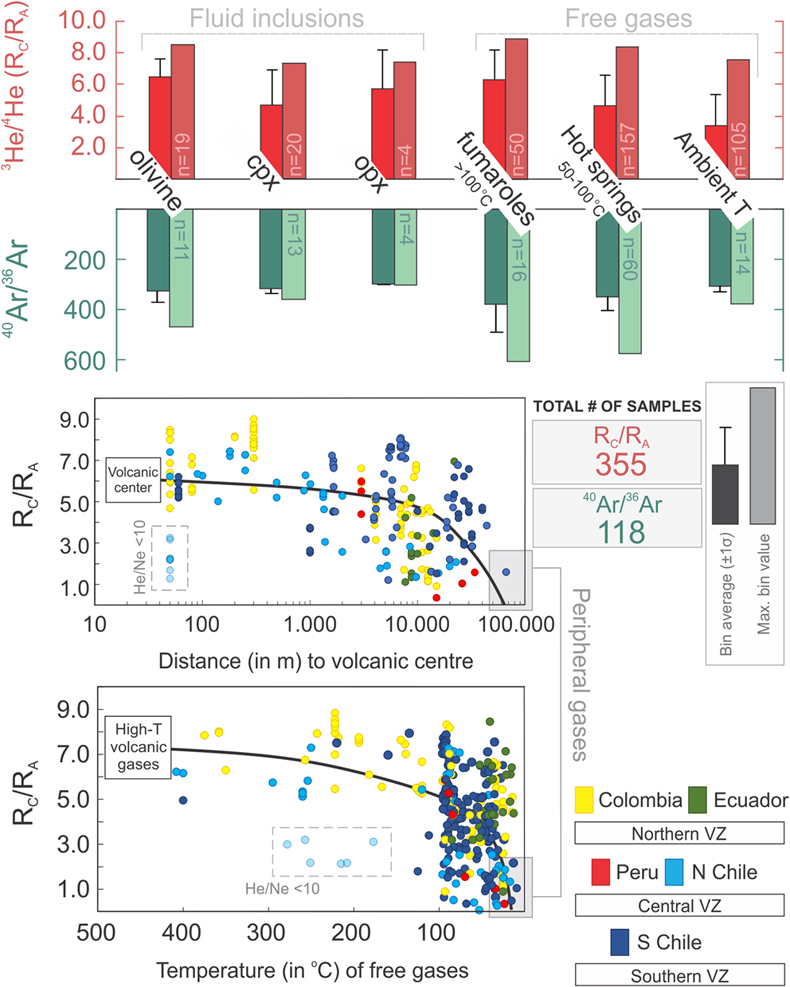
Figure 1 Distribution of helium and argon isotopic data (averages and maximum values) per sample category. Bottom: relation between RC/RA data in free gases, their sampling temperature, and distance to respective volcanic centres (Table S-2).
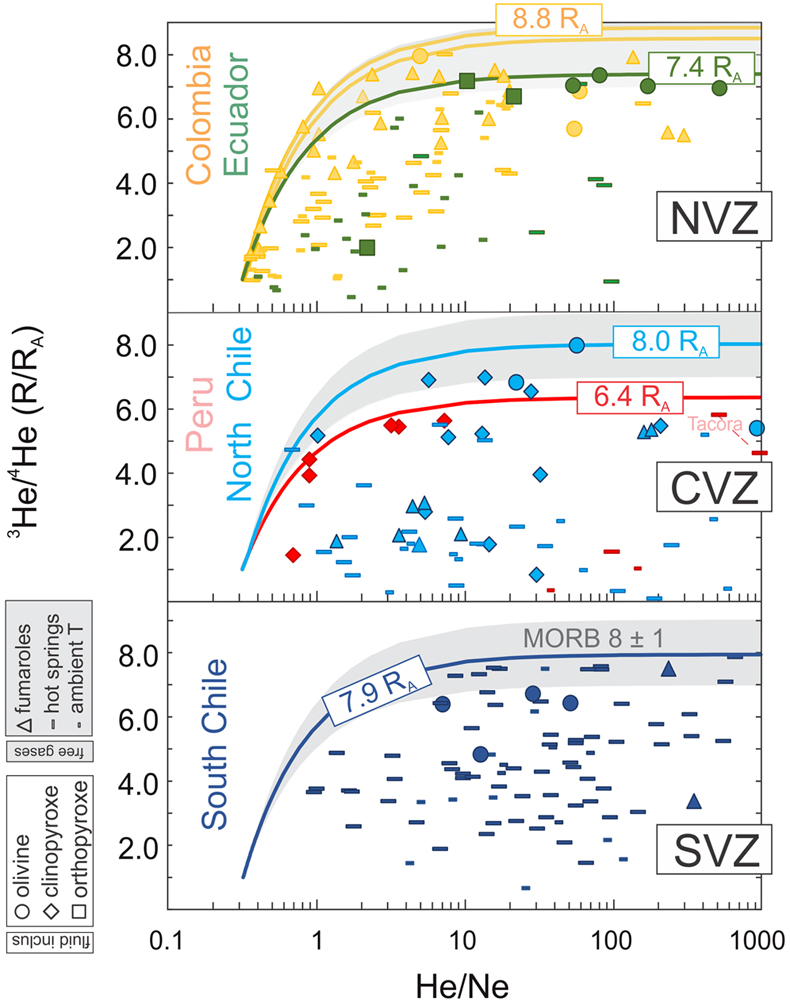
Figure 2 3He/4He vs 4He/20Ne data in FIs and free gases. Binary mixing (air-magmatic end member) curves calculated with maximum RC/RA values for each segment.
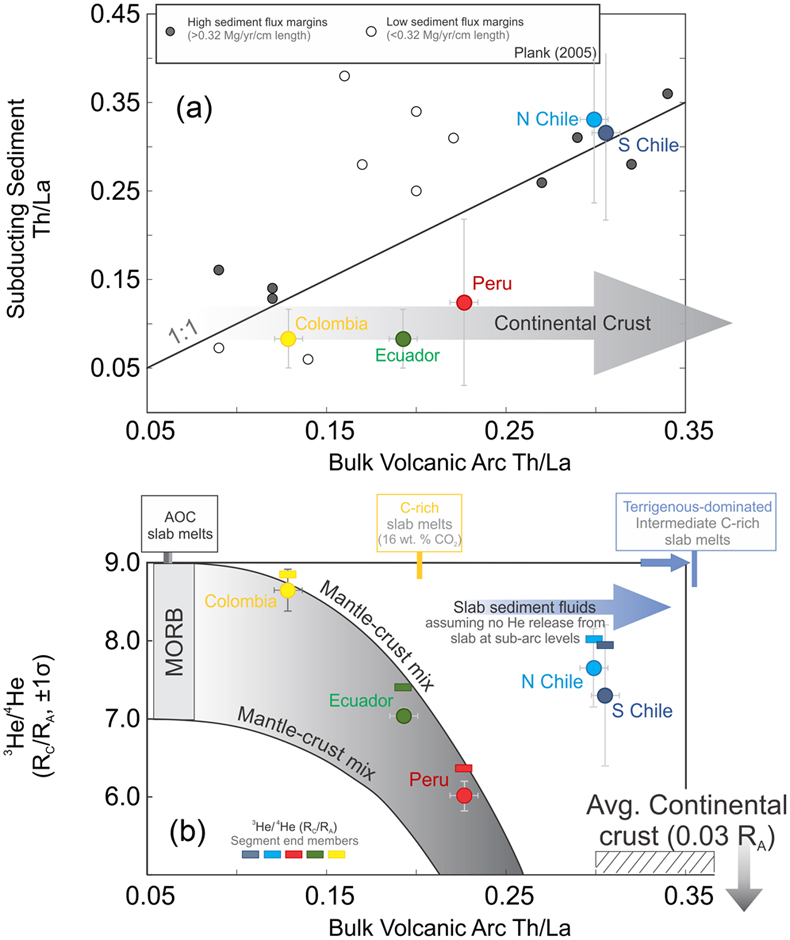
Figure 3 (a) Average Th/La in subducting sediments and volcanic arcs (Plank, 2005
Plank, T. (2005) Constraints from Thorium/Lanthanum on sediment recycling at subduction zones and the evolution of the continents. Journal of Petrology 46, 921–944.
). For Andean segments, bulk sediment and arc compositions (Table S-3) are derived from Plank (2014)Plank, T. (2014) 4.17 - The Chemical Composition of Subducting Sediments. In: Holland, H.D., Turekian, K.K. (Eds.) Treatise on Geochemistry. Second Edition, Elsevier, Oxford, 607–629.
and the Andean GEOROC dataset, respectively (see Supplementary Information S-4). (b) 3He/4He averages and end members (this work) vs. bulk Th/La compositions of respective segments; the grey area indicates a binary mixing line between MORB and continental crust.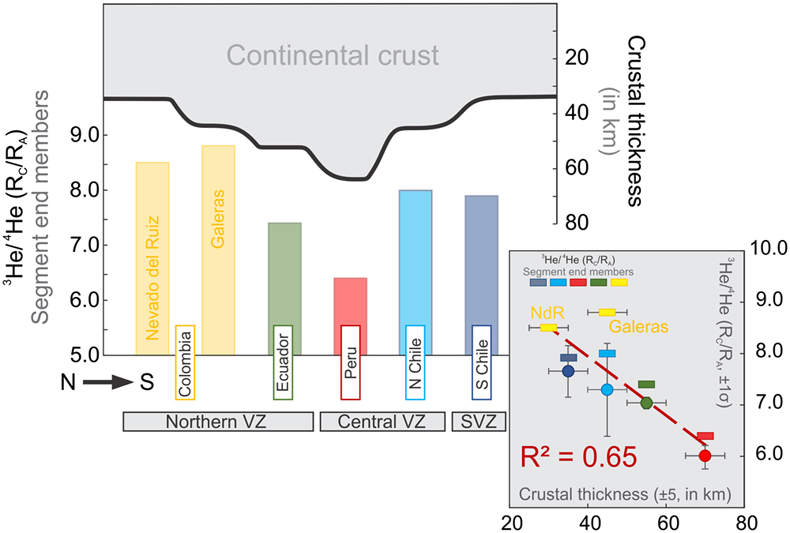
Figure 4 Crustal thickness variations along the Andes (transect); bottom, 3He/4He end members of respective arc segments (Fig. 2). Inset: co-variation of He isotopic signatures (avg. ±1σ, and end members) and crustal thicknesses at the arc scale; due to the crustal thickness anomaly detected at Nevado del Ruiz, the latter and Galeras are plotted separately.






